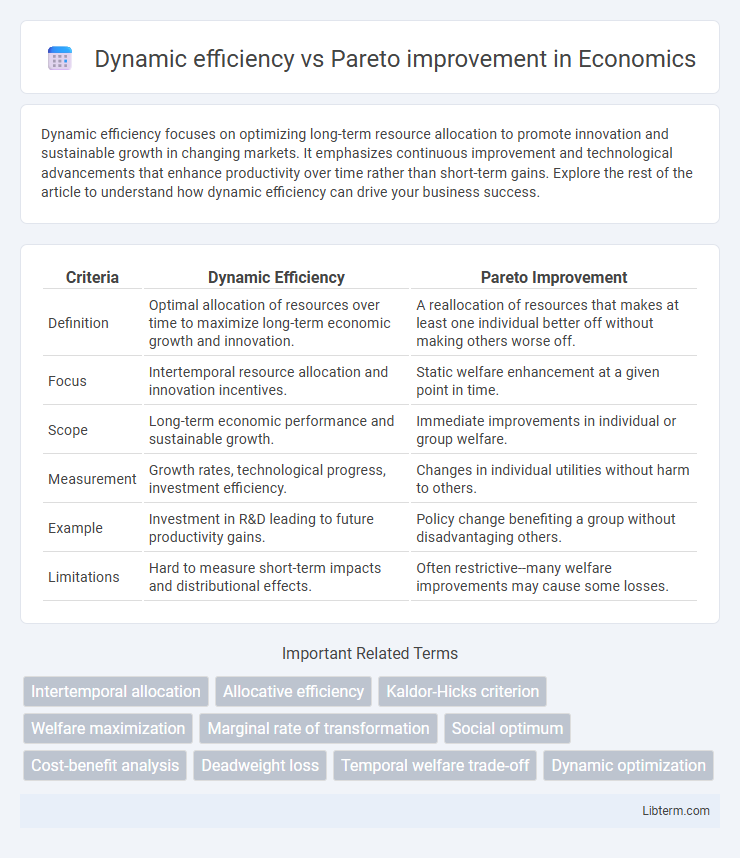Dynamic efficiency focuses on optimizing long-term resource allocation to promote innovation and sustainable growth in changing markets. It emphasizes continuous improvement and technological advancements that enhance productivity over time rather than short-term gains. Explore the rest of the article to understand how dynamic efficiency can drive your business success.
Table of Comparison
| Criteria | Dynamic Efficiency | Pareto Improvement |
|---|---|---|
| Definition | Optimal allocation of resources over time to maximize long-term economic growth and innovation. | A reallocation of resources that makes at least one individual better off without making others worse off. |
| Focus | Intertemporal resource allocation and innovation incentives. | Static welfare enhancement at a given point in time. |
| Scope | Long-term economic performance and sustainable growth. | Immediate improvements in individual or group welfare. |
| Measurement | Growth rates, technological progress, investment efficiency. | Changes in individual utilities without harm to others. |
| Example | Investment in R&D leading to future productivity gains. | Policy change benefiting a group without disadvantaging others. |
| Limitations | Hard to measure short-term impacts and distributional effects. | Often restrictive--many welfare improvements may cause some losses. |
Understanding Dynamic Efficiency
Dynamic efficiency assesses resource allocation over time, prioritizing innovation, technological progress, and sustainable growth to maximize long-term social welfare. It contrasts with Pareto improvement, which focuses on immediate resource reallocation without making any individual worse off. Understanding dynamic efficiency involves evaluating policy impacts on productivity and intergenerational equity, ensuring ongoing improvements rather than short-term gains.
Defining Pareto Improvement
Pareto improvement refers to a resource reallocation where at least one individual's well-being is enhanced without reducing another's welfare, embodying a key principle in welfare economics. Dynamic efficiency, contrastingly, emphasizes optimal resource use over time, ensuring sustainable growth and innovation beyond immediate gains. Understanding Pareto improvements aids in evaluating static allocations, while dynamic efficiency addresses long-term economic development.
Key Differences Between Dynamic Efficiency and Pareto Improvement
Dynamic efficiency emphasizes optimal allocation of resources over time, accounting for innovation, technological progress, and long-term growth, whereas Pareto improvement focuses on reallocations where at least one individual is better off without making anyone else worse off in the short term. Dynamic efficiency integrates intertemporal trade-offs and investment incentives, ensuring sustained economic welfare, while Pareto improvements are static and do not necessarily guarantee future gains or efficiency. Key differences lie in their temporal scope, with dynamic efficiency addressing long-term optimality and Pareto improvement concentrating on immediate, non-worsening changes in welfare.
Importance of Dynamic Efficiency in Economic Growth
Dynamic efficiency drives sustained economic growth by optimizing resource allocation over time, enabling innovation and technological advancement. Unlike Pareto improvement, which focuses on static gains without making anyone worse off, dynamic efficiency emphasizes long-term productivity enhancements and investment in future capabilities. Prioritizing dynamic efficiency ensures economies adapt to changing conditions, fostering continuous development and increased standards of living.
Pareto Improvement in Resource Allocation
Pareto improvement in resource allocation occurs when at least one individual's well-being is enhanced without reducing others' welfare, ensuring a more efficient distribution of resources. This concept prioritizes immediate allocative efficiency by eliminating waste and improving outcomes within existing resources. Unlike dynamic efficiency, which emphasizes long-term innovation and growth, Pareto improvements focus on achieving better resource utilization in the present allocation framework.
Criteria for Achieving Dynamic Efficiency
Dynamic efficiency requires the optimal allocation of resources over time to maximize long-term benefits and innovation, prioritizing sustainable growth and adaptive technologies. Criteria for achieving dynamic efficiency include investing in research and development, fostering competitive markets to incentivize innovation, and ensuring that resource allocation enables continual improvement without depleting future opportunities. Unlike Pareto improvement, which focuses on immediate gains without making anyone worse off, dynamic efficiency emphasizes intertemporal trade-offs and the evolution of economic welfare across generations.
Examples Illustrating Pareto Improvement
Pareto improvements occur when a change benefits at least one party without making anyone worse off, exemplified by trade agreements where countries specialize based on comparative advantage, increasing overall wealth without harming participants. Another example is reallocating resources in a firm to boost productivity and employee satisfaction simultaneously, ensuring no individual's welfare declines. These scenarios contrast with dynamic efficiency, which emphasizes long-term innovation and growth, often involving short-term sacrifices.
Dynamic Efficiency and Technological Advancement
Dynamic efficiency emphasizes long-term productivity gains through continuous technological advancement and innovation, driving economic growth beyond static resource allocation. It prioritizes investments in research and development, human capital, and infrastructure that enhance future production possibilities. This approach contrasts with Pareto improvement, which focuses on immediate gains without diminishing others' welfare, often overlooking the transformative impact of technological progress over time.
Limitations of Pareto Improvement in Real-world Scenarios
Pareto improvement often fails to account for dynamic efficiency, which emphasizes long-term innovation and growth rather than static resource allocation. In real-world scenarios, Pareto improvements can be limited due to difficulties in achieving unanimous agreement among stakeholders and neglecting future benefits from investments not immediately Pareto-optimal. This limitation restricts its applicability in dynamic markets where adaptability and technological progress drive overall welfare improvements.
Policy Implications: Balancing Dynamic Efficiency and Pareto Improvement
Policy implications of balancing dynamic efficiency and Pareto improvement center on designing regulations that foster innovation and long-term growth while ensuring resources are allocated without making any agent worse off. Emphasizing dynamic efficiency encourages investments in technological progress and market adaptability, whereas Pareto improvements require redistribution mechanisms to maintain equity and social welfare. Effective policies integrate incentives for sustainable development with frameworks that accommodate incremental gains benefiting all stakeholders.
Dynamic efficiency Infographic

 libterm.com
libterm.com